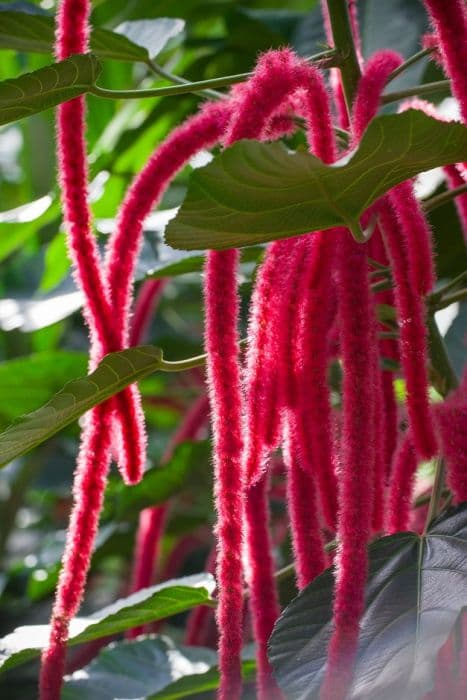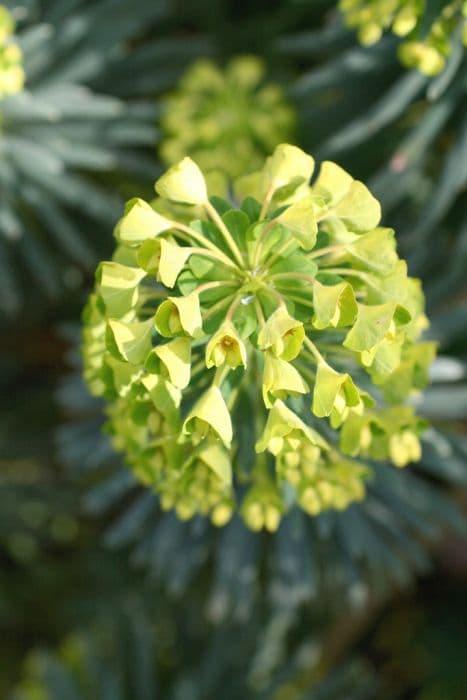Poinsettia Euphorbia pulcherrima Jester Red = 'Eckalverta' (PBR)
![poinsettia [Jester Red]](/_next/image?url=https%3A%2F%2Fplants-admin.emdemapps.com%2Fimages%2Fplants%2F%2Fimages%2F604b55de5eb2c.png&w=3840&q=75)
ABOUT
The Euphorbia pulcherrima Jester Red, more commonly known as the Poinsettia, is a striking ornamental plant renowned for its vibrant and festive coloration. This particular cultivar, 'Eckalverta', boasts large, showy bracts that are traditionally associated with the Christmas season. These bracts are a dazzling red color, with hues that can range from a deep, rich red to a bright, attention-grabbing scarlet, depending on the environment and care it receives. The true flowers of the plant are actually the tiny, inconspicuous yellow structures found at the center of the bracts, known as cyathia. These small flowers are often overlooked due to the dominance of the brilliant red bracts that encircle them. The leaves of the poinsettia are equally attractive, with a dark green color that offers a lush and contrasting backdrop to the red tones of the bracts. The foliage is typically dense, adding to the fullness and robust appearance of the plant. The texture of both the leaves and bracts can be described as smooth, with a slightly leathery feel, which complements the overall elegance of the poinsettia. The plant's branching structure is well-balanced, allowing the bracts to spread out and showcase their full splendor. This symmetrical growth habit makes the poinsettia an excellent choice for decorative displays and centerpieces during the holiday season and beyond. Overall, the Euphorbia pulcherrima Jester Red 'Eckalverta' (PBR), with its lush foliage and vivid red bracts, is a delightfully ornamental plant that captures the essence of festive cheer, making it a beloved addition to homes and public spaces during the winter months.
About this plant
 Names
NamesFamily
Euphorbiaceae
Synonyms
Jester Red Poinsettia, Christmas Flower, Christmas Star, Winter Rose, Lobster Plant, Flame Leaf Flower, Jester Red Christmas Plant
Common names
Euphorbia pulcherrima 'Eckalverta'
 Toxicity
ToxicityTo humans
The plant in question is commonly known as Poinsettia. It is generally considered to be of low toxicity to humans. However, if ingested, it can cause mild irritation to the mouth and stomach, potentially leading to nausea, vomiting, or diarrhea. Contact with the skin can sometimes result in irritation or an allergic reaction, and the sap may cause irritation to the eyes. It is advisable to wash hands after handling the plant to avoid any potential irritation.
To pets
Poinsettias are also considered to be of low toxicity to pets, such as cats and dogs. However, ingestion can lead to similar symptoms as in humans, such as nausea, vomiting, or diarrhea, and sometimes excessive drooling. If a pet consumes part of a Poinsettia, it is recommended to monitor for any adverse reactions and consult a veterinarian if any concerning symptoms develop.
 Characteristics
CharacteristicsLife cycle
Perennials
Foliage type
Evergreen
Color of leaves
Green
Flower color
Red
Height
1-2 feet (30-60 cm)
Spread
1-2 feet (30-60 cm)
Plant type
Shrub
Hardiness zones
9
Native area
Mexico
Benefits
 General Benefits
General Benefits- Decorative Appeal: Euphorbia pulcherrima Jester Red, commonly known as Poinsettia, has vibrant red foliage that provides festive color during the holiday season.
- Enhances Mood: The bright coloring of the Poinsettia can improve mood by adding a cheerful and decorative touch to interior environments.
- Suitable for Holiday Decor: Poinsettias are synonymous with Christmas decor, making them ideal for use in seasonal displays and arrangements.
- Low Maintenance: Poinsettias require minimal care, making them suitable for people with busy lifestyles or those who are not experienced gardeners.
- Long-Lasting Color: These plants can retain their color for months with proper care, providing a prolonged period of enjoyment.
- Adaptability: Poinsettias can adapt to various indoor environments as long as they are kept away from drafts and extreme temperatures.
- Versatile Gift Option: Due to their association with the holiday season, Poinsettias make a popular and thoughtful gift during winter holidays.
- Supports Local Economy: Poinsettias are often grown by local nurseries and greenhouses, and purchasing them supports small businesses.
 Medical Properties
Medical PropertiesThis plant is not used for medical purposes.
 Air-purifying Qualities
Air-purifying QualitiesThis plant is not specifically known for air purifying qualities.
 Other Uses
Other Uses- Natural Dye: The bracts of the poinsettia can be used to produce a red dye for fabrics or as a colorant in cosmetics.
- Educational Tool: Poinsettias are often used in schools and educational workshops to demonstrate photoperiodism—the effect of light and dark periods on plant physiology.
- Art and Craft Projects: The colorful bracts can be used in collages or as natural decorative elements in various art projects.
- Seasonal Festivities: Dried poinsettia bracts can be used as confetti or decoration during Christmas and winter celebrations.
- Photography Prop: Poinsettias can be used as vibrant subjects or backdrops in photography, especially during the holiday season.
- Table Centerpieces: The whole plant or just its bracts can be used to make creative and festive centerpieces for tables at events or in homes.
- Living Mulch: When not in flower, the poinsettia can be used as living mulch to suppress weeds and help retain soil moisture in gardens.
- Plant Sculpture: Poinsettias can be pruned and shaped into various forms for display as living sculptures in gardens and landscapes.
- Theme Parties: For themed parties or events, such as a 'Christmas in July', poinsettias can add a touch of authenticity to the décor.
- Color Themed Gardens: Poinsettias can be planted as part of a color-themed garden design, providing vivid red hues during their blooming season.
Interesting Facts
 Feng Shui
Feng ShuiThe Poinsettia is not used in Feng Shui practice.
 Zodiac Sign Compitability
Zodiac Sign CompitabilityThe Poinsettia is not used in astrology practice.
 Plant Symbolism
Plant Symbolism- Christmas Celebration: Euphorbia pulcherrima, commonly known as the Poinsettia, is widely recognized for its association with Christmas due to its vibrant red and green foliage, symbolizing the festive season.
- Joy: The bright red color of the Poinsettia is often connected with happiness and celebration, making it a symbol of joy during the holiday season.
- Good Cheer: As a popular Christmas plant, Poinsettias are believed to bring good cheer and are often given as gifts to spread holiday spirit.
- Success: The star-shaped leaf pattern is sometimes considered a symbol of the Star of Bethlehem, which signifies success and achievement.
- Prosperity: In some cultures, the Poinsettia's lush, full leaves are emblematic of growth and abundance, evoking a sense of prosperity.
 Water
WaterThe poinsettia requires consistent, measured watering to maintain moist soil. Water your poinsettia when the surface of the soil feels dry to the touch. Give the plant about 16 ounces of water every 1-2 weeks, but adjust the amount based on the size of the pot and the environmental conditions. Always allow excess water to drain away, as poinsettias do not like to sit in water. During the blooming period, keep a slightly more regular watering schedule to support the plant's needs.
 Light
LightPoinsettias prefer bright, indirect sunlight for at least six hours per day. An ideal spot is near a sunny window where the plant will receive plenty of light but is shielded from the direct rays of the sun, which can scorch the leaves. Avoid low-light conditions, as they can cause the plant to become leggy and lose its vibrant color.
 Temperature
TemperaturePoinsettias thrive in temperatures between 65-75 degrees Fahrenheit. They can survive a minimum temperature of 50 degrees Fahrenheit, but prolonged exposure to cold can be harmful. Avoid placing your poinsettia in draughty areas or near sudden temperature changes which can cause leaf drop. The maximum temperature for a poinsettia should not exceed 80 degrees Fahrenheit, as higher temperatures may lead to poor leaf coloration and reduced blooming.
 Pruning
PruningPoinsettias should be pruned to encourage bushiness and to maintain an attractive shape. Trim back the plant after it finishes blooming, around late winter or early spring. Prune or pinch back the tips of new growth every couple of months until the early autumn to promote more branches. The best time for pruning is when the stems are new, and before the flower buds have developed.
 Cleaning
CleaningAs needed
 Soil
SoilPoinsettias require a well-draining potting mix with good aeration; a blend of peat moss, perlite, and vermiculite is ideal. They prefer a slightly acidic soil pH, generally between 5.5 and 6.5 to thrive optimally.
 Repotting
RepottingPoinsettias should be repotted every year after their blooming season ends, typically in spring. It's important to ensure they're placed in fresh potting mix to provide nutrients for the next growing season.
 Humidity & Misting
Humidity & MistingPoinsettias fare best in moderate to high humidity levels, around 50-60%. They can be sensitive to dry air, so maintaining adequate humidity is crucial for their well-being.
 Suitable locations
Suitable locationsIndoor
Place in bright, indirect light and avoid cold drafts.
Outdoor
Ensure bright, indirect sunlight and shelter from wind.
Hardiness zone
9-11 USDA
 Life cycle
Life cycleEuphorbia pulcherrima Jester Red, commonly known as Jester Red Poinsettia, begins its life cycle as a seed, which, when sown and subjected to the right environmental conditions, germinates into a young seedling. Once the seedling emerges, it enters a vegetative growth phase, developing roots, stems, and leaves as it matures into an established plant. Controlled environmental factors such as light and temperature influence the poinsettia to enter a photoperiodic stage, where shorter daylight hours lead to the development of its characteristic bright red bracts, signaling the flowering phase. Following pollination (often manually assisted), the plant may produce seeds, although commercial propagation typically occurs through cuttings to maintain cultivar traits. After the blooming period, the plant may enter a period of dormancy, particularly when exposed to adverse conditions or after the holiday season when indoor plants are frequently discarded. With proper care, however, the poinsettia can be induced to re-bloom year after year, continuing its life cycle through pruning and reconditioning for the next festive season.
 Propogation
PropogationPropogation time
Early Spring
The most popular method of propagating Poinsettia 'Eckalverta' is through cuttings. This process typically starts in late spring or early summer when the plant's growth is most active. A healthy, non-flowering shoot about 4 to 6 inches (10 to 15 centimeters) is cut just below a leaf node. The lower leaves are removed, and the cut end is dipped in a rooting hormone to encourage root development. The cutting is then placed in a mixture of moist peat and perlite, ensuring that at least one or two leaf nodes are buried in the medium. The pot is covered with a plastic bag to maintain high humidity, and placed in indirect light. Roots usually develop within a few weeks, after which the new plant can be transferred to a pot with standard potting soil.









